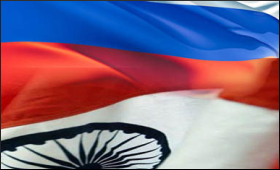|
|
|

|
Deepening collaboration between Russia and India sustains a multipolar world
|
|

|
|
| Top Stories |
 |
|
|
|
IANS | 21 Sep, 2022
The 'special and privileged strategic partnership' between India and
Russia, as referred to by Prime Minister Narendra Modi at the Eastern
Economic Forum, opens up new areas of mutually beneficial cooperation
between the two countries.
In the field of trade
relations, for example, there has been a significant increase in
cooperation. According to India's Ministry of Commerce and Industry,
trade turnover between Russia and India reached $13.7 billion during the
first six months of 2022, up 2.7 times over the same period in 2021.
Russian
Ambassador to India, Denis Alipov, provided similar data at the recent
SCO Summit in Uzbekistan. According to him, trade turnover between
Russia and India saw 'unprecedented growth' in the first half of 2022
and reached over $11 billion, which is promising in terms of reaching
the goal of $30 billion in mutual trade by 2025.
This growth was
mainly due to increased exports from Russia to India (up 3.4 times in
first six months of 2022 as compared to the first six months of 2021),
primarily mineral fuel (six times higher, according to India).
As
of April 2022, Russia was India's fourth largest supplier of oil. In
addition, according to the Indian Minister of Metallurgy, the country
also plans to increase its purchases of coal from Russia. In May 2022,
India abolished import Customs duties on this product.
At the
same time, a number of imports from Russia continue to be restricted by
the existence of a 7.5 per cent duty (+0.75 per cent additional
charges). Some experts claim that this situation is constraining the
development of the Indian economy. Late last year, India and the EAEU,
along with Armenia, Belarus, Kazakhstan, Kyrgyzstan and Russia as member
states, carried out expert consultations on establishing a free trade
area (FTA) and agreed to start the corresponding negotiations early this
year. Unfortunately, the Russia-Ukraine conflict caused certain delays
in this process. For all parties involved, it is now important that
these negotiations do not come to a complete standstill.
Another
important focus to further intensify the cooperation between India and
Russia should be on ensuring that all transport corridors operate to a
high level of quality. We are now seeing signs of activation in the
North-South corridor, which had long been forgotten. From India, goods
go to the Iranian port of Chabahar, then through the Iranian railways to
the North, from there to Astrakhan from the North Iranian ports and
from there to Central Russia.
There are many areas that need to
be strengthened in order to preserve and accelerate India-Russia
relations and prevent them from stagnating in a rapidly-changing world.
Though a number of initiatives have been proposed between Indian-Russian
institutions, they are on the slow track, and are in need of
acceleration. These include the International North-South Transport
Corridor, free trade agreements, labour visas, better mechanisms for
rupee-rouble trade and links with banks. This acceleration process
requires political will and creativity, and would offer huge advantages
to both India and Russia.
In 2022, Russia and India celebrate 75
years of diplomatic relations. After many years of building partnership
and collaboration, the interaction between these two countries needs to
be strengthened and accelerated in order to sustain a multipolar world.
|
|
|
| |
|
|
|
|
|
|
|
|
|
|
|
|
|
|
| |
| Customs Exchange Rates |
| Currency |
Import |
Export |
US Dollar
|
₹84.00
|
₹82.25 |
UK Pound
|
₹104.65
|
₹108.10 |
Euro
|
₹92.50
|
₹89.35 |
| Japanese
Yen |
₹56.10 |
₹54.40 |
| As on 25 Jul, 2025 |
|
|
| Daily Poll |
 |
 |
| Who do you think will benefit more from the India - UK FTA in the long run?
|
|
|
|
|
|
| Commented Stories |
 |
|
|
|
|
|
| |
|